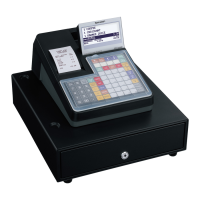
Do you have a question about the Sharp ER-A280F and is the answer not in the manual?
| Types of payment | Cash |
|---|---|
| Keyboard number of keys | 70 |
| Supported paper width | 58 mm |
| RS-232 ports | 4 |
| Operating temperature (T-T) | 0 - 40 °C |
| Depth | 365 mm |
|---|---|
| Width | 330 mm |
| Height | 225 mm |
| Weight | 9000 g |
Overview of the different operating modes supported by the register, such as REG, PGM, and others.
Detailed steps on how to select the desired operating mode from the mode selection window.
Methods for entering single items using department or PLU/EAN codes.
Procedures for entering PLU, subdepartment, and EAN sales data.
Setting up promotions like discounts or free items based on purchase criteria.
Linking PLU/EAN codes to register them automatically together.
Modifying the price or associated department of an EAN item.
Procedures for handling cash or check payments and calculating change.
Handling transactions paid with combinations of cash, check, and credit.
Procedures for processing credit card payments and entries.
Explanation of the six programmable VAT/tax calculation systems.
Voiding the most recent entry made during a transaction.
Voiding entries made earlier in a transaction using cursor or sequence.
Voiding an entire transaction after a subtotal has been calculated.
Procedure to access the manager mode using a secret code.
How to override programmed limits and limitations using manager mode.
Correcting entries that cannot be voided by other methods via manager mode.
Detailed steps for generating daily (X1/Z1) and periodic (X2/Z2) sales reports.
Table detailing various reports, their descriptions, and data entry requirements.
Sample format for the general daily sales report (X1 and Z1).
Daily sales reports broken down by department and department groups.
Explains declaration types and provides step-by-step key operation instructions.
Procedures for entering alphanumeric characters, digits, and special symbols.
General guidelines and overview of the register's programming interface.
Explanation of the programming screen layout and how to navigate menus.
A step-by-step example demonstrating how to program a department.
Procedure to select options within the article programming group.
How to program department settings like price, text, tax, and commission.
Programming settings for PLU (Product Look-Up) and EAN (barcode) codes.
Linking PLU or EAN codes together for single-key activation.
Configuring promotion tables for discounts, free items, and special offers.
Assigning departments or PLUs directly to keyboard keys for quick access.
Programming custom text descriptions for various register functions.
Programming clerk details: secret code, name, and mode access permissions.
Programming cashier details: secret code, name, and mode access permissions.
Programming manager codes and secret codes for administrative access.
Setting the current date and time for accurate transaction logging.
Programming tax rates, signs, and lowest taxable amounts for tax categories.
Procedure for clearing data from the register's memory.
Overview of transactable codes like UPC-A, EAN-8, EAN-13, and their number system characters.
Programming the date and time for automatic EURO modification operations.
Steps to select and set the EURO status (B, C, or D) for modification.
How the register behaves during power failures and printer errors.
Instructions for installing and removing paper rolls from the printer.
Checklist for common faults and potential causes before contacting service.